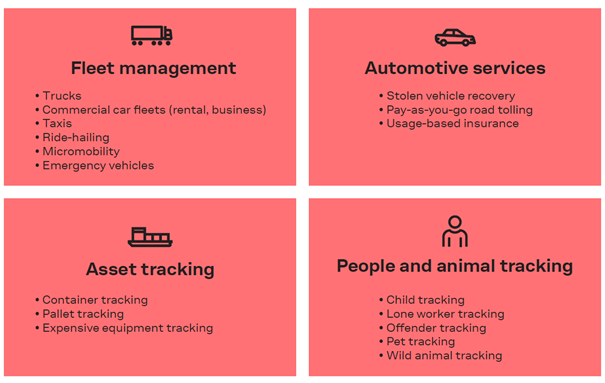
- Support portal
- Evaluation Kits and partner products
u-blox Support
- Product documentation
Documentation
- Investor relations
Investor relations
Tech
|
07 Dec 2020
Combining GNSS positioning and LPWA cellular communication, u-blox combo modules meet the accuracy, reliability, security, size, and cost requirements of most common business verticals and application areas.

Over the past years, expectations on the performance of tracking and telematics solutions have been rapidly rising. While accuracy, size, and price have long dominated sales pitches, factors such as coverage, availability, security, power consumption, and full life-time support have been gaining in importance. This trend has been paralleled by rapid market growth, with ever more varied tracking and telematics use cases relying on satellite-based positioning and cellular communication technology.

Common use cases for IoT tracking solutions.
Finding the optimal balance between functionality, performance, and cost can be challenging. At u-blox, we offer a wide range of solutions to implement tracking and telematics solutions. Combining a stand-alone GNSS receiver with cellular communication module offers customizable solutions delivering state-of-the-art performance. Alternatively, our SARA-R422M8S, and SARA-R510M8S IoT module solutions combine the technologies into a single module designed to avoid some of the limitations of competing solutions on the market.
In the past, IoT tracking solutions have typically been composed of fully independent modules: (a) a GNSS receiver with its own RF front-end and antenna, mounted alongside (b) a cellular modem, it too connected to its own RF front-end and antenna. Seeking to reduce the size and bill of materials (BOM) of their solutions, hardware vendors have scaled them down by shedding some components, and fitting all the elements onto a single piece of silicon in a system-on-chip (SoC) design.
Architectural differences between stand-alone, system-on-chip, and combo IoT tracking solutions.
This, however, has come at a cost, both in terms of performance of the GNSS positioning receiver and of the cellular modem. In most solutions, the GNSS receiver and the cellular modem share a common RF front-end, rendering concurrent GNSS signal reception and cellular signaling impossible. Others have shaved 3dB off of the maximum transmit power of their cellular modems to reduce their bill of materials, but resulting in retransmissions, higher latencies, higher power consumption, and reduced coverage in challenging environments, such as indoors and at cell edges.
Recognizing the value of small and cost-effective products for the IoT tracking market, yet unwilling to accept the compromises associated with the system-on-chip (SoC) architecture, we at u-blox have pursued an alternative approach, which we refer to as a combo solution. Our combo solutions are the first tracking offering on the market to be based on a complete chip-down design, offering fully integrated GNSS positioning and cellular communication functionality in a single module without compromising performance.
To learn more about our u-blox IoT tracking combo modules, download our white paper: Selecting the right hardware architecture for IoT tracking solutions.
In our white paper, you’ll find out:
Samuele Falcomer
Product Management Cellular, u-blox Italy